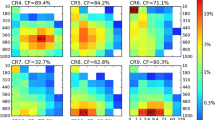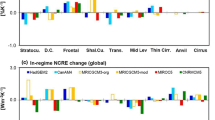Abstract
The radiative feedback from clouds remains the largest source of variation in climate sensitivity amongst general circulation models (GCMs). A cloud clustering methodology is applied to six contemporary GCMs in order to provide a detailed intercomparison and evaluation of the simulated cloud regimes. By analysing GCMs in the context of cloud regimes, processes related to particular cloud types are more likely to be evaluated. In this paper, the mean properties of the global cloud regimes are evaluated, and the cloud response to climate change is analysed in the cloud-regime framework. Most of the GCMs are able to simulate the principal cloud regimes, however none of the models analysed have a good representation of trade cumulus in the tropics. The models also share a difficulty in simulating those regimes with cloud tops at mid-levels, with only ECHAM5 producing a regime of tropical cumulus congestus. Optically thick, high top cloud in the extra-tropics, typically associated with the passage of frontal systems, is simulated considerably too frequently in the ECHAM5 model. This appears to be a result of the cloud type persisting in the model after the meteorological conditions associated with frontal systems have ceased. The simulation of stratocumulus in the MIROC GCMs is too extensive, resulting in the tropics being too reflective. Most of the global-mean cloud response to doubled CO2 in the GCMs is found to be a result of changes in the cloud radiative properties of the regimes, rather than changes in the relative frequency of occurrence (RFO) of the regimes. Most of the variance in the global cloud response between the GCMs arises from differences in the radiative response of frontal cloud in the extra-tropics and from stratocumulus cloud in the tropics. This variance is largely the result of excessively high RFOs of specific regimes in particular GCMs. It is shown here that evaluation and subsequent improvement in the simulation of the present-day regime properties has the potential to reduce the variance of the global cloud response, and hence climate sensitivity, amongst GCMs. For the ensemble of models considered in this study, the use of observations of the mean present-day cloud regimes suggests a potential reduction in the range of climate sensitivity of almost a third.














Similar content being viewed by others
References
Anderberg MR (1973) Cluster analysis for applications. Academic, New York, p 359
Boer GJ, Yu B (2003) Climate sensitivity and response. Clim Dyn 20:415–429
Bony S, Dufresne JL (2005) Marine boundary layer clouds at the heart of cloud feedback uncertainties in climate models. Geophys Res Lett 32(20):L20806
Bony S, Dufresne JL, Le Treut H, Morcrette JJ, Senior CA (2004) On dynamic and thermodynamic components of cloud changes. Clim Dyn 22:71–86
Cess RD, Potter GL, Blanchet JP, Boer GJ, Delgenio AD, Dequé M, Dymnikov V, Galin V, Gates WL, Ghan SJ, Kiehl JT, Lacis AA, Le Treut H, Li ZX, Liang XZ, McAveney BJ, Meleshko VP, Mitchell JFB, Morcrette JJ, Randall DA, Rikus L, Roeckner E, Royer JF, Shlese U, Sheinin DA, Slingo A, Sokolov AP, Taylor KE, Washington WM, Wetherald RT, Yagai I, Zhang MH (1990) Intercomparison and interpretation of climate feedback processes in 19 atmospheric general circulation models. J Geophys Res 95:16601–16615
Cubasch U, Meehl GA, Boer GJ, Stouffer RJ, Dix M, Noda A, Senior CA, Raper SCB, Yap KS (2001) Projections of future climate change. In: Houghton JT, Ding Y, Griggs DJ, Noguer M, van der Linden P, Dai X, Maskell K, Johnson CI (eds) Climate change 2001: the scientific basis. contribution of working group I to the third assessment report of the intergovernmental panel on climate change. Cambridge University Press, London, pp 525–582
Haywood JM, Allan RP, Culverwell I, Slingo A, Milton S, Edwards JM, Clerbaux N (2005) Can desert dust explain the outgoing longwave radiation anomaly over the Sahara during July 2003? J Geophys Res 110(D05105)
Jakob C, Tselioudis G (2003) Objective identification of cloud regimes in the Tropical Western Pacific. Geophys Res Lett 30(21)
Jakob C, Tselioudis G, Hume T (2005) The radiative, cloud and thermodynamic properties of the major Tropical Western Pacific cloud regimes. J Clim 18:1203–1215
Johns TC, Durman CF, Banks HT, Roberts MJ, McLaren AJ, Ridley JK, Senior CA, Williams KD, Jones A, Rickard GJ, Cusack S, Ingram WJ, Crucifix M, Sexton DMH, Joshi MM, Dong BW, Spencer H, Hill RSR, Gregory JM, Keen AB, Pardaens AK, Lowe JA, Bodas-Salcedo A, Stark S, Searl Y (2006) The new Hadley Centre climate model HadGEM1: evaluation of coupled simulations. J Clim 19(7):1327–1353
K-1 model developers (2004) K-1 coupled model (MIROC) description. K-1 technical report 1. In: Hasumi H, Emori S (eds) Center for Climate System Research. University of Tokyo
Kalnay E, Kanamitsu M, Kistler R, Collins W, Deaven D, Gandin L, Iredell M, Saha S, White G, Woollen J, Zhu Y, Chelliah M, Ebisuzaki W, Higgins W, Janowiak J, Mo KC, Ropelewski C, Wang J, Leetmaa A, Reynolds R, Jenne R, Joseph D (1996) The NCEP/NCAR 40-year reanalysis project. Bull Am Meteorol Soc 77(3):437–471
Klein SA, Hartmann DL (1993) The seasonal cycle of low stratiform clouds. J Clim 6(8):1587–1606
Klein SA, Jakob C (1999) Validation and sensitivities of frontal clouds simulated by the ECMWF model. Mon Weather Rev 127(10):2514–2531
Klein SA, Hartmann DL, Norris JR (1995) On the relationships among low-cloud structure, sea-surface temperature and atmospheric circulation in the summertime northeast Pacific. J Clim 8(5):1140–1155
Martin GM, Bush MR, Brown AR, Lock AP, Smith RNB (2000) A new boundary layer mixing scheme. Part II: tests in climate and mesoscale models. Mon Weather Rev 128(9):3200–3217
Martin GM, Ringer MA, Pope VD, Jones A, Dearden C, Hinton TJ (2006) The physical properties of the atmosphere in the new Hadley Centre Global Environmental Model (HadGEM1). Part I: model description and global climatology. J Clim 19:1274–1301
McAvaney BJ, Le Treut H (2003) The cloud feedback intercomparison project: (CFMIP). In: CLIVAR Exchanges—supplementary contributions. 26 March
Norris JR, Weaver CP (2001) Improved techniques for evaluating GCM cloudiness applied to the NCAR CCM3. J Clim 14:2540–2550
Ogura T, Emori S, Tsushima Y, Abe-Ouchi A, Kimoto M (2007) Climate sensitivity of a general circulation model with different cloud modelling assumptions. J Meteorol Soc Jpn (submitted)
Pope VD, Gallani ML, Rowntree PR, Stratton RA (2000) The impact of new physical parametrizations in the Hadley Centre climate model—HadAM3. Clim Dyn 16:123–146
Ringer MA, Allan RP (2004) Evaluating climate model simulations of tropical cloud. Tellus 56:308–327
Ringer MA, McAvaney B, Andronova N, Buja L, Esch M, Ingram W, Li B, Quaas J, Roeckner E, Senior C, Soden B, Volodin E, Webb M, Williams K (2006) Global mean cloud feedbacks in idealized climate change experiments. Geophys Res Lett 33:L07718
Roeckner E, Bauml G, Bonaventura L, Brokopf R, Esch M, Giorgetta M, Hagemann S, Kirchner I, Kornblueh L, Manzini E, Rhodin A, Schlese U, Schulzweida U, Tompkins A (2003) The atmospheric general circulation model ECHAM 5. Part I: model description. Technical Report 349, Max Planck Institute for Meteorology
Rossow WB, Schiffer RA (1991) ISCCP cloud data products. Bull Am Meteorol Soc 72:2–20
Rossow WB, Walker AW, Beuschel DE, Roiter MD (1996) International Satellite Cloud Climatology Project (ISCCP) documentation of new cloud datasets. WMO/TD 737, World Meteorological Organisation, p 115
Rossow WB, Tselioudis G, Polak A, Jakob C (2005) Tropical climate described as a distribution of weather states indicated by distinct mesoscale cloud property mixtures. Geophys Res Lett 32(21)
Senior CA, Mitchell JFB (1993) Carbon dioxide and climate: The impact of cloud parameterization. J Clim 6:393–418
Soden BJ, Held IM (2006) An assessment of climate feedbacks in coupled ocean-atmosphere models. J Clim 19:3354–3360
Tompkins AM, Craig GC (1999) Sensitivity of tropical convection to sea surface temperature in the absence of large-scale flow. J Clim 12(2):462–476
Tselioudis G, Jakob C (2002) Evaluation of midlatitude cloud properties in a weather and a climate model: dependence on dynamic regime and spatial resolution. J Geophys Res 107(D24):4781
Tselioudis G, Zhang Y, Rossow WB (2000) Cloud and radiation variations associated with northern midlatitude low and high sea level pressure regimes. J Clim 13(2):312–327
Wang J, Rossow WB, Uttal T, Rozendaal M (1999) Variability of cloud vertical structure during ASTEX observed from a combination of rawinsonde, radar, ceilometer, and satellite. Mon Weather Rev 127(10):2484–2502
Webb M, Senior C, Bony S, Morcrette JJ (2001) Combining ERBE and ISCCP data to assess clouds in the Hadley Centre, ECMWF and LMD atmospheric climate models. Clim Dyn 17:905–922
Webb MJ, Senior CA, Sexton DMH, Ingram WJ, Williams KD, Ringer MA, McAvaney BJ, Colman R, Soden BJ, Gudgel R, Knutson T, Emori S, Ogura T, Tsushima Y, Andronova NG, Li B, Musat I, Bony S, Taylor KE (2006) On the contribution of local feedback mechanisms to the range of climate sensitivity in two GCM ensembles. Clim Dyn 27(1):17–38
Wetherald RT, Manabe S (1988) Cloud feedback processes in a general circulation model. J Atmos Sci 45:1397–1415
Williams KD, Senior CA, Mitchell JFB (2001) Transient climate change in the Hadley Centre models: the role of physical processes. J Clim 14(12):2659–2674
Williams KD, Ringer MA, Senior CA (2003) Evaluating the cloud response to climate change and current climate variability. Clim Dyn 20:705–721
Williams KD, Senior CA, Slingo A, Mitchell JFB (2005) Towards evaluating cloud response to climate change using clustering technique identification of cloud regimes. Clim Dyn 24:701–719
Williams KD, Ringer MA, Senior CA, Webb MJ, McAvaney BJ, Andronova N, Bony S, Dufresne JL, Emori S, Gudgel R, Knutson T, Li B, Lo K, Musat I, Wegner J, Slingo A, Mitchell JFB (2006) Evaluation of a component of the cloud response to climate change in an intercomparison of climate models. Clim Dyn 26:145–165
Winton M (2005) Simple optical models for diagnosis surface – atmosphere shortwave interactions. J Clim 18:3796–3805
Zhang Y, Rossow WB, Lacis AA, Oinas V, Mishchenko MI (2004) Calculation of radiative fluxes from the surface to top of atmosphere based on ISCCP and other global data sets: refinements of the radiative transfer model and input data. J Geophys Res 109(D19,105)
Zhang MH, Lin WY, Klein SA, Bacmeister JT, Bony S, Cederwall RT, Del Genio AD, Hack JJ, Loeb NG, Lohmann U, Minnis P, Musat I, Pincus R, Stier P, Suarez MJ, Webb MJ, Wu JB (2005) Comparing clouds and their seasonal variations in 10 atmospheric general circulation models with satellite measurements. J Geophys Res 110(D15)
Acknowledgements
This work was funded under the UK Government Meteorological Research programme. We thank Tomoo Ogura for submitting MIROC data and Johannas Quaas for submitting ECHAM5 data to CFMIP. Thanks go to Mark Ringer, Mark Webb, Catherine Senior, Tony Slingo, Christian Jakob, Michel Crucifix and William Ingram for useful discussions during this study and for their comments on early drafts of the paper. ISCCP data were obtained from the NASA Langley Research Center Atmospheric Sciences Data Center. NCEP reanalysis data were provided by the NOAA-CIRES Climate Diagnostics Center, Boulder, Colorado, USA, from their web site at http://www.cdc.noaa.gov.. ERA-40 data were obtained from ECMWF.
Author information
Authors and Affiliations
Corresponding author
Electronic supplementary material
Below is the link to the electronic supplementary material.
Rights and permissions
About this article
Cite this article
Williams, K.D., Tselioudis, G. GCM intercomparison of global cloud regimes: present-day evaluation and climate change response. Clim Dyn 29, 231–250 (2007). https://doi.org/10.1007/s00382-007-0232-2
Received:
Accepted:
Published:
Issue Date:
DOI: https://doi.org/10.1007/s00382-007-0232-2




